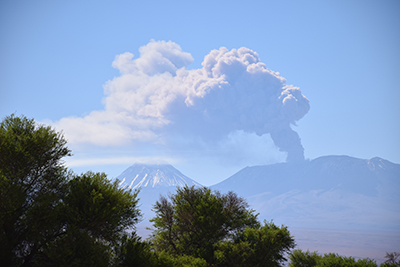Volcanic ash is a spectacular companion of volcanic activity that carries valuable information about the subsurface processes. It also poses a range of severe hazards to public health, infrastructure, aviation, and agriculture, and it plays a significant role in biogeochemical cycles.
Scientists can examine ash particles from volcanic eruptions for clues to the history of their journey from the lithosphere (Earth’s crust and upper mantle) to the atmosphere, hydrosphere, and biosphere (Figure 1). These tephra particles are less than 2 millimeters in diameter, and they record most of the history on or near their surfaces. Understanding the physicochemical properties of the ash particle surfaces is essential to deciphering the underlying volcanic and atmospheric processes and to predicting the widespread effects and hazards posed by these small particles.

Leading volcanic ash research groups gathered in September 2016 for a workshop at the Universität Hamburg, Germany, organized by the university’s Institute for Geophysics and Institute for Geology. Thirty experts, including 12 early-career scientists, discussed the life cycle, hazards, and environmental effects of volcanic ash to integrate the developments in this field and foster collaborations. Specialists from geochemistry, geology, volcanology, and atmospheric sciences brought experimental, observational, and modeling perspectives to the workshop. Discussions focused on the pros and cons of existing practices in fundamental and applied research, and participants elaborated on future best practices.
For example, ash surface generation and alteration through processes occurring during eruption (e.g., fragmentation and recycling) and after eruption (e.g., aggregation, cloud chemistry, and microphysics) are not yet quantitatively well understood and thus are not fully implemented in the models. Therefore, gaps remain in our understanding of the volcanic and atmospheric life cycle of the ash and how this life cycle is linked to the surface properties and environmental effects of the ash.
This limitation hinders the reliable estimation of far-field airborne ash concentrations, a central factor in assessing the ash hazard for aviation. Workshop participants agreed that tackling these issues would require combining recent experimental and observational data on rate parameters of physicochemical processes and ash surface characteristics with advanced atmospheric models that incorporate aerosol chemistry, microphysics, and interactions among aerosols, clouds, and solar radiation.

The workshop emphasized that addressing the challenges in volcanic ash surface characterization requires close collaboration of experts in laboratory experiments, in situ measurements, space-based observations, and numerical modeling to codevelop reliable assessment tools for both fundamental research and operational purposes. Workshop participants made several suggestions on how to establish such an alliance:
- initiate a collaborative network with two working groups on the physical and geochemical life cycles of volcanic ash
- develop an integrated modeling, observational, and experimental data compilation on mid- to large-intensity eruptions to assist with benchmark modeling
- organize a joint session of the European Geosciences Union (EGU) and American Geophysical Union (AGU) to foster the coupling of modeling and experimental research on volcanic ash
These actions will be linked to the existing activities within the International Association of Volcanology and Chemistry of the Earth’s Interior, EGU, and AGU.
The workshop was supported by the excellence cluster CliSAP (DFG EXE 177).
—Gholam Ali Hoshyaripour (email: [email protected]), Institute of Geophysics, Research Centre for Earth System Research and Sustainability, Universität Hamburg, Germany
Citation:
Hoshyaripour, G. A. (2017), Volcanic ash particles hold clues to their history and effects, Eos, 98, https://doi.org/10.1029/2017EO070621. Published on 03 April 2017.
Text © 2017. The authors. CC BY-NC-ND 3.0
Except where otherwise noted, images are subject to copyright. Any reuse without express permission from the copyright owner is prohibited.

